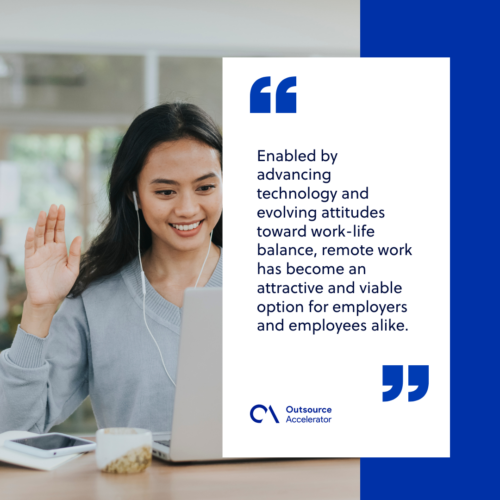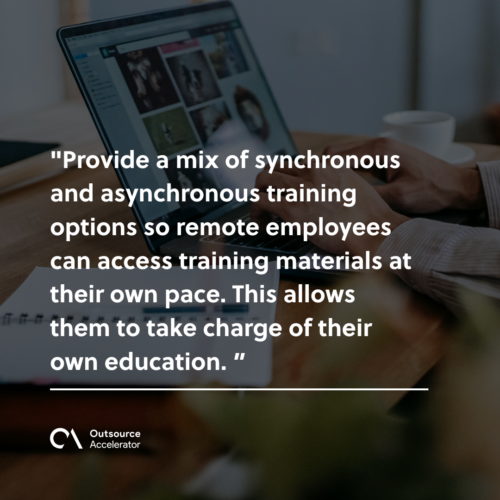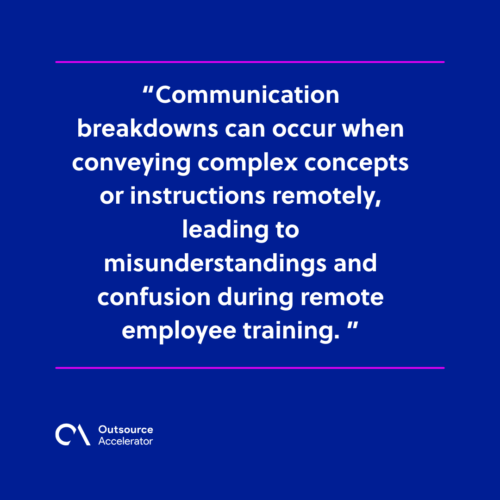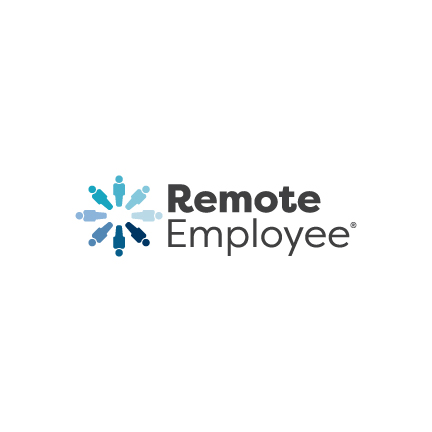The basics of remote employee training

Understanding remote employee training
The shift to remote employment has become more than a trend. It’s evolved into a fundamental aspect of modern business operations, and thus remote employee training must be prioritized to meet this new direction.
“Just because a company has transitioned to remote work does not mean that it is operating at its fullest potential. Proper training is essential for companies to fully realize the benefits of remote work and avoid common pitfalls.” – Dr. Gleb Tsipursky, CEO of Disaster Avoidance Experts.
In the wake of this new paradigm, the need for effective remote employee training has never been more critical.
Beyond mere adaptation to virtual environments, successful remote employee training programs are pivotal to equipping the skills needed to thrive digitally.
In this article, we’ll examine the fundamentals of remote employee training and explore strategies and solutions for creating impactful online learning experiences in the workplace.
We’ll discuss the use of virtual tools and platforms, setting objectives, and flexible options to enhance the employee development process.
The rise of remote work
The rise of remote work has revolutionized the traditional notion of the workplace.
Enabled by advancing technology and evolving attitudes toward work-life balance, remote work has become an attractive and viable option for employers and employees alike.
As of 2023, working from home increased five-fold from 2019. WFHResearch reports that 40% of US employees now work remotely for at least one day a week.
There now exist various tools that make it possible for remote teams to function as efficiently as their in-office counterparts, such as:
- Video conferencing platforms
- Project management tools
- Instant messaging applications
- Cloud-based storage systems

Additionally, the COVID-19 pandemic has accelerated this adoption. Forced to embrace remote work, many businesses gained insights into the effectiveness of this model.
This paradigm shift underscores the resilience of businesses and highlights the workforce’s ingenuity in navigating modern problems.
What is remote employee training?
Remote employee training is the process of providing instruction, guidance, and development opportunities to employees working outside the traditional office setting.
It’s designed to equip remote workers with the same level of support and development as their in-office counterparts.
Unlike traditional in-person training methods, remote employee training utilizes various platforms, digital tools, and virtual communication channels. This addresses the unique challenges of remote work.
Remote employee training encompasses a wide range of learning initiatives, such as:
- Orientation programs
- Technical skills training
- Compliance training
- Leadership development
- Ongoing professional development
This approach allows organizations to adequately onboard new hires, upgrade skills, and promote continuous learning among their remote workforce.
Strategies for remote employee training
Strategies for remote employee training are essential for ensuring effective learning outcomes and professional development in a distributed work environment.
Here are some key strategies to consider:
Utilize technology and digital tools
Take advantage of various technological tools and platforms to facilitate remote employee training.
- Use video conferencing tools for live training sessions or virtual classrooms.
- Utilize learning management systems to deliver and track training content.
- Provide access to digital resources and materials.
Organizations can use these platforms to access materials, track progress, and facilitate discussions and assessments in a remote setting.
Use a variety of learning formats
Incorporate a mix of learning formats, including:
- Online courses
- Virtual workshops
- Video tutorials
- Interactive modules
Creating multimedia-rich content helps to engage different learning styles and keeps remote employees motivated and interested.
Establish clear learning objectives
Clearly define the learning objectives and outcomes of each training module to provide direction and focus for remote employees. The steps they should follow should also be precise, making it easier for them to navigate through the training program.
For example, you can set goals similar to these for your remote training strategy:
- “After two weeks, remote employees should be able to demonstrate proficiency in project management software to track and manage tasks.”
- “Remote employees should attain a minimum score of 90% in the compliance assessment to ensure a thorough understanding of remote data security protocols.”
- “By the end of the training period, remote employees will be able to handle customer inquiries with a response time of under X hours.”
Align these objectives with organizational goals and individual development plans to ensure relevance and applicability.
Offer flexibility and self-paced learning options
Recognize that remote employees may have different schedules and work arrangements.
Provide a mix of synchronous and asynchronous training options so remote employees can access training materials at their own pace. This allows them to take charge of their own education.

Encourage autonomy and initiative in exploring relevant topics and seeking out additional support as needed.
Facilitate virtual collaboration
Encourage cooperation and a feeling of community among remote employees. Empower them to actively participate in group discussions, virtual team projects, and online forums.
Here are some ways you can do this:
- Encourage experienced employees to conduct virtual mentorship sessions with new hires.
- Arrange virtual shadowing sessions where remote employees in training can join client calls as observers.
- Structure training programs to include collaborative project assignments where trainees work together.
- Form virtual peer learning groups where remote employees can share their experiences, discuss challenges, and exchange knowledge.
Virtual collaborations enhance learning outcomes and promote a culture of continuous improvement.
Provide ongoing support and feedback
Offer remote employees access to mentors, subject matter experts, and training facilitators who can provide guidance, support, and feedback during the training process.
Regular check-ins, progress reviews, and constructive feedback sessions are essential for facilitating continuous learning and development.
Evaluate and iterate
Continuously monitor the effectiveness of your remote employee training initiatives through:
- Feedback surveys
- Performance metrics
- Assessment results
Use the data to identify areas for improvement, refine training strategies, and address any gaps or challenges that arise.
Overcoming challenges of remote employee training
Here are some common challenges that you may encounter in remote employee training and how to overcome them:
Lack of engagement
Disengagement is already a problem without considering the remote factor. Gallup noted that only 32% of US workers reported being engaged, down from the 34% in 2021.
Employees may struggle to stay engaged during remote employee training due to the absence of social factors.
Foster engagement by incorporating interactive elements such as polls, quizzes, breakout sessions, and group discussions. Encourage participation through frequent interaction and inspire remote employees to share their experiences and insights.
Technology issues
Remote employee training heavily relies on technology, and technical issues can disrupt the learning experience.
These can come in the form of:
- Connectivity problems
- Software glitches
- Unfamiliarity with technology platforms
Provide technical support resources and troubleshooting guides to help employees resolve common issues. Conduct technology orientation sessions before the actual remote employee training begins to familiarize them with the tools being used.
Communication barriers
Communication breakdowns can occur when conveying complex concepts or instructions remotely, leading to misunderstandings and confusion during remote employee training.
Use clear and concise language when delivering instructions and explanations. Establish open communication channels where remote employees can ask questions and seek clarification.
It might also be helpful to use visual aids, diagrams, and demonstrations to enhance understanding.

Distractions
Harvard Business Review found that 60.6% of employees get distracted during the workday. Remote employees also face various distractions from their remote workspace.
To overcome this, encourage employees to create a dedicated workspace free from distractions. Set clear expectations, create a schedule, and practice time management techniques to help employees stay focused.
A distraction-free workspace includes these elements:
- Minimal clutter
- Clear surfaces
- Proper lighting
- Minimized external noise
- Privacy and boundaries
Don’t forget to incorporate frequent breaks into remote employee training sessions to allow people to recharge.
Find world-class talent with Remote Employee
Remote work continues to redefine the way we approach professional development and training. It matters that businesses partner with those who understand the unique needs and challenges of the remote workforce.
Remote Employee stands out as a premier solution, offering comprehensive services tailored to empower remote teams worldwide.
The firm is a veteran of coordinating teams across different time zones to deliver quality outsourcing solutions. Its reliable technology and communication systems ensure that remote employees receive first-rate training, all for the service of your customers.
Whether you’re seeking to enhance your remote employee training initiatives, streamline your recruitment, or expand your remote team, Remote Employee is your trusted partner all the way.







 Independent
Independent




